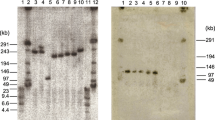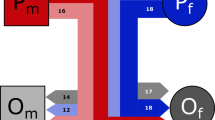Summary
Two distinct members of the LINE-1 (L1) family in Peromyscus were characterized. The two clones, denoted L1Pm55 and L1Pm62, were 1.5 kb and 1.8 kb in length, respectively, and align to the identical region of the L1 sequence of Mus domesticus. Sequence similarity was on the order of 70% between L1Pm55 and L1Pm62, which approximates that between either Peromyscus sequence and Mus Ll. L1Pm62 represents a more prevalent subfamily than L1Pm55. L1Pm62 exists in about 500 copies per haploid genome, while L1Pm55 exists in about 100 copies. The existence of major and minor subpopulations of L1 within Peromyscus is in contrast to murine rodents and higher primates, where L1 copy number is on the order of 20,000 to 100,000, and where levels of intraspecific divergence among L1 elements are typically less than 15–20%. Additional Peromyscus clones are similarly divergent from both L1Pm62 and LIPm55, implying the existence of more than two distinct L1 subfamilies. The highly divergent L1 subfamilies in Peromyscus apparently have been evolving independently for more than 25 million years, preceding the divergence of cricetine and murine rodents. Investigations of the evolution of L1 within Peromyscus by restriction and Southern analysis was performed using species groups represented by the partially interfertile species pairs P. maniculatus-P. polionotus, P. leucopus-P. gossypinus, and P. truei-P. difficilis of the nominate subgenus and P. californicus of the Haplomylomys subgenus. Changes in L1 and species group taxonomic boundaries frequently coincided. The implications for phylogeny are discussed.
Similar content being viewed by others
References
Bailey WJ, Fitch DHA, Tagle DA, Czelusniak J, Slightom JL, Goodman M (1991) Molecular evolution of the ψη-globin gene locus: gibbon phylogeny and the hominoid slowdown. Mol Biol Evol 8:155–184
Baker RJ, Wichman HA (1991) Retrotransposion Mys is concentrated on the sex chromosomes: implications for copy number containment. Evolution 44:2081–2088
Bennett KL, Hill RE, Pietras DF, Woodworth-Gutai M, Kane-Haas C, Houston JM, Heath JK, Hastie ND (1984) Most highly repeated dispersed DNA families in the mouse genome. Mol Cell Biol 4:1561–1571
Benson SA, Taylor RK (1984) A rapid small-scale procedure for isolation of phage lambda DNA. Biotechniques 2:126–127
Blair WF (1943) Criteria for species and their subdivisions from the point of view of genetics. NY Acad Sci 44:179–188
Blin N, Stafford DW (1976) A general method for the isolation of high molecular weight DNA from eukaryotes. Nucl Acids Res 3:2303–2308
Bonhomme EF, Catalan J, Britten-Davidian J, Chapman K, Moriwaki K, Nevo E, Thaler L (1984) Biochemical diversity and evolution in the genus Mus. Biochem Genet 22:275–303
Brown SDM, Dover G (1981) Organization and evolutionary progress of a dispersed repetitive family of sequences in widely separated rodent genomes. J Mol Biol 150:441–466
Burton FH, Loeb DD, Voliva CF, Martin SL, Edgell MH, Hutchison III CA (1986) Conservation throughout mammalia and extensive protein-encoding capacity of the highly repeated DNA long interspersed sequence one. J Mol Biol 1987:291–304
Carleton MD (1989) Systematics and evolution. In: Kirkland GL Jr, Layne JN (eds) Advances in the study of Peromyscus (Rodentia). Texas Tech University Press, Lubbock, pp 7–142
Casavant NC, Hardies SC, Funk FD, Comer MB, Edgell MH, Hutchison III CA (1988) Extensive movement of LINES ONE sequences in beta-globin loci of Mus caroli and Mus domesticus. Mol Cell Biol 8:4669–4674
Chapman VM, Nichols EA, Ruddle RH (1974) Esterase-8 (Es-8): characterization, polymorphism, and linkage of an erythrocytic esterase locus on chromosome 7 of Mus musculus. Biochem Genet 11:347–358
Devereux J, Haeberli P, Smithies O (1984) A comprehensive set of sequence analysis programs for the VAX. Nucl Acids Res 12:387–395
Dice LR (1968) Speciation. In: King JA (ed) Biology of Peromyscus (Rodentia). Spec Publ 2, American Society of Mammalogists, pp 75–97
Dover G (1982) Molecular drive: A cohesive mode of species evolution. Nature 299:111–117
Fanning T, Singer M (1987) The LINE-1 DNA sequences in four mammalian orders predict proteins that conserve homologies to retrovirus proteins. Nucl Acids Res 15:2251–2260
Flamm WG, Bond HE, Burr HE (1966) Density-gradient centrifugation of DNA in a fixed-angle rotor. A higher order of resolution. Biochim Biophys ACTA 129:310–319
Gebhard W, Meitinger T, Hochtl J, Zachau HG (1982) A new family of interspersed DNA sequences in the mouse genome. J Mol Biol 157:453–471
Ginzburg LR, Bingham PM, Yoo S (1984) On the theory of speciation induced by transposable elements. Genetics 107:331–341
Hall ER (1981) The mammals of North America, 2nd ed. John Wiley and Sons, New York
Hardies SC, Martin SL, Voliva CF, Hutchison III CA, Edgell MH (1986) An analysis of replacement and synonymous changes in the rodent L1 repeat family. Mol Biol Evol 3:109–125
Heinkoff S (1984) Unidirectional digestion with exonuclease III creates targeted breakpoints for DNA sequencing. Gene 28:351–359
Hooper ET (1968) Classification. In: King JA (ed) Biology of Peromyscus (Rodentia). Spec Publ 2, American Society of Mammalogists, pp 27–74
Hutchison CA III, Hardies SC, Loeb DD, Shehee WR, Edgell MH (1989) LINEs and related retroposons: long interspersed repeated sequences in the eucaryotic genome. In: Berg DE, Howe MM (eds) Mobile DNA. American Society of Microbiologists, Washington DC, pp 594–617
Hwu HR, Roberts JW, Davidson EH, Britten RJ (1986) Insertion and/or deletion of many repeated DNA sequences in human and higher ape evolution. Proc Natl Acad Sci USA 83:3875–3879
Jubier-Martin V, Dod BJ, Bellis M, Piechaczyk M, Roizes G (1985) Comparative study of the Ll family in the genus Mus: Possible role of retroposition and conversion events in its concerted evolution. J Mol Biol 184:547–564
Jurka J (1989) Subfamily structure and evolution of the human L1 family of repetitive sequences. J Mol Evol 29:496–503
Jurka J, Milosavljevic A (1991) Reconstruction and analysis of human Alu genes. J Mol Evol 32:105–121
Kimura M (1977) Preponderance of synonymous changes as evidence for the neutral theory of molecular evolution. Nature 267:275–276
Li W-H, Gojobori T, Nei M (1981) Pseudogenes as a paradigm of neutral evolution. Nature 292:237–239
Li W-H, Tanimura M, Sharp PM (1987) An evaluation of the molecular clock hypothesis using mammalian DNA sequences. J Mol Evol 25:330–342
Loeb DD, Padgett RW, Hardies SC, Shehee WR, Comer MB, Edgell MH, Hutchison III CA (1986) The sequence of a large L1Md element reveals a tandemly repeated 5′ end and several features found in retrotransposons. Mol Cell Biol 6:168–182
Maniatis T, Fritsch EF, Sambrook J (1982) Molecular cloning. A laboratory manual. Cold Spring Harbor Laboratory, Cold Spring Harbor, NY
Martin SL, Voliva CF, Burton FH, Edgell MH, Hutchison III CA (1984) A large interspersed repeat found in mouse DNA contains a long ORF that evolves as if it encodes a protein. Proc Nail Acad Sci USA 81:2308–2312
Martin SL, Voliva CF, Hardies SC, Edgell MH, Hutchison III CA (1985) Tempo and mode of concerted evolution in the L1 repeat family of mice. Mol Biol Evol 2:127–140
Ohta T, Dover GA (1984) The cohesive population genetics of molecular drive. Genetics 108:501–521
Osgood WH (1909) Revision of the mice of the American genus Peromyscus. N Am Fauna 28:1–285
Padgett RW, Loeb DD, Snyder LRG, Edgell MH, Hutchison III CA (1987) The molecular organization of the beta-globin complex of the deer mouse, Peromyscus maniculatus. Mol Bio Evol 4:31–45
Padgett RW, Hutchison III CA, Edgell MH (1988) The F-type 5′ motif of mouse L1 elements: a major class of L1 termini similar to the A-type in organization but unrelated in sequence. Nucl Acids Res 16:739–749
Pascale E, Valle E, Furano AV (1990) Amplification of an ancestral mammalian L1 family of long interspersed repeated DNA occurred just before the murine radiation. Proc Natl Acad Sci USA 87:9481–9485
Paulson KE, Deka N, Schmid CW, Misra R, Schindler CW, Rush MG, Kadyk L, Leinwand L (1985) A transposon-like element in human DNA. Nature 316:359–361
Rose MR, Doolittle WF (1983) Molecular biological mechanisms of speciation. Science 220:157–162
Shehee WR, Chao S-F, Loeb DD, Comer MB, Hutchison III CA, Edgell MH (1987) Determination of a functional ancestral sequence and definition of the 5′ end of A-type mouse L1 elements. J Mol Biol 196:757–767
Singer MF (1982) SINEs and LINES: highly repeated short and long interspersed sequences in mammalian genomes. Cell 28:433–434
Skowronski J, Fanning TG, Singer MF (1988) Unit-length LINE-1 transcripts in human teratocarcinoma cells. Mol Cell Biol 8:1385–1397
Skowronski J, Singer MF (1986) The abundant LINE-1 family of repeated DNA sequences in mammals: genes and pseudogenes. Cold Spring Harbor Symp Quant Biol 51:457–464
Soares MB, Schon E, Efstratiadis A (1985) Rat LINE 1: the origin and evolution of long interspersed middle repetitive DNA elments. J Mol Evol 22:117–133
Southern EM (1975) Detection of specific sequences among DNA fragments separated by gel electrophoresis. J Mol Biol 98:503–517
Stangl FB Jr, Baker RJ (1984) Evolutionary relationships in Peromyscus: congruence in chromosomal, genic and classical data sets. J Mamm 65:643–654
Thaler L, Bonhomme F, Britton-Davidian J (1981) Processes of speciation and semi-speciation in the house mouse. Symp Zool Soc Lond 47:27–41
Voliva CF, Jahn CL, Comer MB, Hutchison III CA, Edgell MH (1983) The L1 long interspersed repeat family in the mouse: almost all examples are truncated at one end. Nucl Acids Res 11:8847–8859
Voliva CF, Martin SL, Hutchison III CA, Edgell MH (1984) Dispersal process associated with the L1 family of interspersed repetitive DNA sequences. J Mol Biol 178:795–813
Wichman HA, Potter SS, Pine DS (1985) Mys, a family of mammalian transposable elements isolated by phylogenetic screening. Nature 317:77–81
Author information
Authors and Affiliations
Rights and permissions
About this article
Cite this article
Kass, D.H., Berger, F.G. & Dawson, W.D. The evolution of coexisting highly divergent line-1 subfamilies within the rodent genus Peromyscus . J Mol Evol 35, 472–485 (1992). https://doi.org/10.1007/BF00160208
Revised:
Accepted:
Issue Date:
DOI: https://doi.org/10.1007/BF00160208




